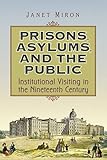Prisons, Asylums, and the Public : Institutional Visiting in the Nineteenth Century / Janet Miron.
Material type: TextPublisher: Toronto : University of Toronto Press, [2011]Copyright date: ©2011Description: 1 online resource (240 p.)Content type:
TextPublisher: Toronto : University of Toronto Press, [2011]Copyright date: ©2011Description: 1 online resource (240 p.)Content type: - 9780802095138
- 9781442661639
- 365.60971090
- online - DeGruyter
| Item type | Current library | Call number | URL | Status | Notes | Barcode | |
|---|---|---|---|---|---|---|---|
 eBook
eBook
|
Biblioteca "Angelicum" Pont. Univ. S.Tommaso d'Aquino Nuvola online | online - DeGruyter (Browse shelf(Opens below)) | Online access | Not for loan (Accesso limitato) | Accesso per gli utenti autorizzati / Access for authorized users | (dgr)9781442661639 |
Browsing Biblioteca "Angelicum" Pont. Univ. S.Tommaso d'Aquino shelves, Shelving location: Nuvola online Close shelf browser (Hides shelf browser)

|

|

|

|

|

|

|
||
| online - DeGruyter Curriculum Reform in Ontario : 'Common-Sense' Policy Processes and Democratic Possibilities / | online - DeGruyter The Sixties and Beyond : Dechristianization in North America and Western Europe, 1945-2000 / | online - DeGruyter Bringing in the Sheaves : Economy and Metaphor in the Roman World / | online - DeGruyter Prisons, Asylums, and the Public : Institutional Visiting in the Nineteenth Century / | online - DeGruyter Critical Ecologies : The Frankfurt School and Contemporary Environmental Crises / | online - DeGruyter Inheriting a Canoe Paddle : The Canoe in Discourses of English-Canadian Nationalism / | online - DeGruyter Urban Sustainability : Reconnecting Space and Place / |
Frontmatter -- Contents -- List of Illustrations -- Acknowledgments -- Introduction -- 1. The Establishment of Custodial Institutions and the Early Practice of Visiting -- 2. Open Doors: Welcoming the Public into Prisons and Asylums -- 3. ‘You Must Go!’: Visitors to Prisons and Asylums -- 4. ‘I Am Even Afraid That She Put Her Tongue Out’: Inmate and Patient Responses to Visitors -- 5. ‘What We Saw with Our Own Eyes’: Visiting and Nineteenth- Century Culture -- 6. ‘To Avoid Exposure and Publicity’: Opposition to Visiting -- 7. ‘Behind Closed Doors’: The Changing Relationship between Custodial Institutions and Society -- Conclusion -- Appendix: The Setting -- Notes -- Bibliography -- Index
restricted access online access with authorization star
http://purl.org/coar/access_right/c_16ec
The prisons and asylums of Canada and the United States were a popular destination for institutional tourists in the nineteenth-century. Thousands of visitors entered their walls, recording and describing the interiors, inmates, and therapeutic and reformative practices they encountered in letters, diaries, and articles. Surprisingly, the vast majority of these visitors were not members of the medical or legal elite but were ordinary people.Prisons, Asylums, and the Public argues that, rather than existing in isolation, these institutions were closely connected to the communities beyond their walls. Challenging traditional interpretations of public visiting, Janet Miron examines the implications and imperatives of visiting from the perspectives of officials, the public, and the institutionalized. Finding that institutions could be important centres of civic activity, self-edification, and 'scientific' study, Prisons, Asylums, and the Public sheds new light on popular nineteenth-century attitudes towards the insane and the criminal.
Mode of access: Internet via World Wide Web.
In English.
Description based on online resource; title from PDF title page (publisher's Web site, viewed 01. Dez 2023)


